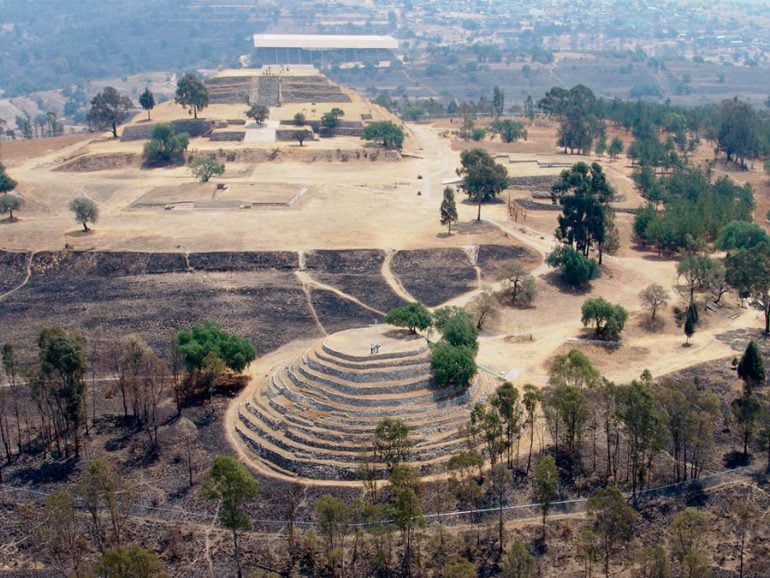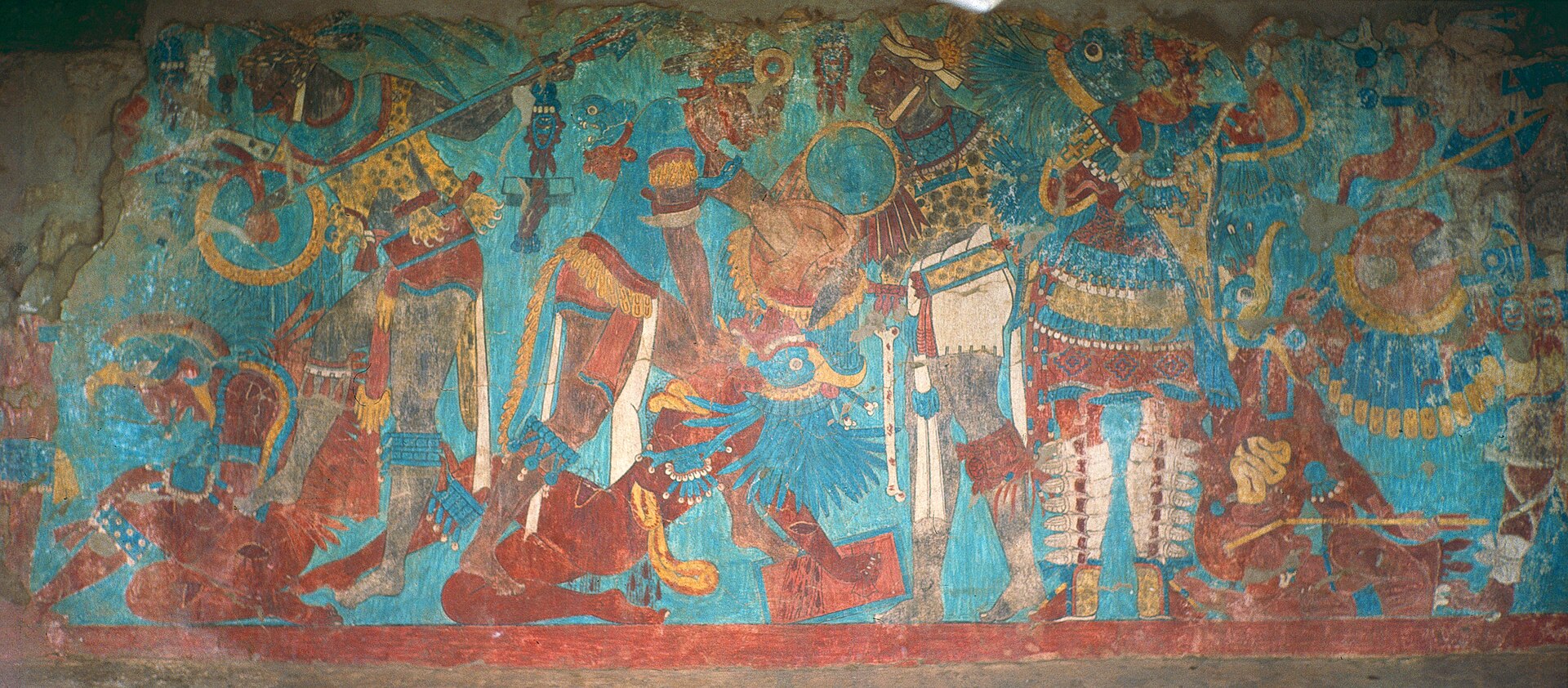Welcome to DU!
The truly grassroots left-of-center political community where regular people, not algorithms, drive the discussions and set the standards.
Join the community:
Create a free account
Support DU (and get rid of ads!):
Become a Star Member
Latest Breaking News
General Discussion
The DU Lounge
All Forums
Issue Forums
Culture Forums
Alliance Forums
Region Forums
Support Forums
Help & Search
Latin America
Related: About this forumThe ancient city of Cacaxtla ruled supreme until a volcano erupted

Edificio de la Espiral The Edificio de la Espiral (The Spiral Building). PHOTOS BY JOSEPH SORRENTINO
Published on Monday, September 12, 2022
At the southern end of Tlaxcala lies the ruins of a city you may not be familiar with — Cacaxtla, which exerted military and economic control over much, if not most, of the Puebla-Tlaxcala Valley and regions as far away as the Gulf Coast and the Mexican basin. That is, until the Popocatépetl volcano erupted in A.D. 1000 and it was abandoned.
Actually, its decline, according to historians, began about 100 years earlier. But during its peak, between A.D. 650 and A.D. 900, it was a powerful city, united for about 300 years with another city a short distance away by the name of Xochitécatl.
All that can be seen of Cacaxtla today is a large pyramid called El Gran Basamento (Great Platform) and some surrounding smaller pyramids. Elites and priests — almost certainly all men — ruled over and had exclusive use of Cacaxtla. Women were the ones who held fertility rituals at Xochitécatl, rituals in which everyone could take part.

Cacaxtla site
The Pyramid of the Flowers shot through a corridor in El Gran Basamento, showing the path that leads from Cacaxtla to Xochitépetl, a nearby ancient city with which Cacaxtla had an alliance.
Like Cacaxtla, Xochitécatl was abandoned when Popocatépetl erupted in A.D. 1000.
Although Cacaxtla had been described by Diego Muñoz Camargo, a 16th-century historian, it nevertheless remained unknown in modern times until it was accidentally rediscovered by maintenance workers in 1975. Shortly afterward, archeologists began excavating the site for the next six years.
Cacaxtla, the capital city in an area occupied by a group known as the Olmeca-Xicalancas, was first settled 2,500 years ago, although it’s not clear who the first inhabitants were. Its name means “Place of the Cacaxtles,” which were boxes that were used to carry a variety of products.
More:
https://mexiconewsdaily.com/mexicolife/the-ancient-city-of-cacaxtla-ruled-supreme-until-a-volcano-erupted/
~ ~ ~

CACAXTLA & XOCHITECATL & PUEBLA
Main Information
Cacaxtla and Xochitecatl – the political, military and economic capital of the pre-Hispanic world of the Puebla-Tlaxcala valley after the fall of Teotihuacan and Cholula.
Archaeological research conducted in the eastern part of this ancient city since its discovery in the 1970s revealed one of the most important centers that developed in the Epiclassical period (650-900 N.E.) in Mesoamerica.
Cacaxtla managed to establish trade relations up to the Gulf Coast and the Caribbean of Mexico.
Here are the Great Temple, the Temple of Venus, the Red Temple, many original frescoes. The city was erected on the top of the hill of Xocitecatl with the adaptation of architecture and landscape. The most important monuments here are located on elevations, these are the Pyramid of Flowers, the Pyramid of the Serpent, etc. This magnificent city has been developing since the formation period (600-100 BC).
The archaeological zone of Cacastla is located in the city of San Miguel del Milagro at a distance of 110 km from the capital of Mexico, about two hours of the road.
More:
https://arminastravel.com/excersions/cacaxtla-xochitecatl-puebla/
~ ~ ~
Murals of Cacaxtla
Nativitas, Mexico
These strikingly colorful paintings were created by a mysterious Mesoamerican civilization.


CACAXTLA IS ONE OF THE less-visited Mesoamerican archeological sites. As such, it’s unlikely you’ll see hordes of tourists while you visit. But you will, however, see a fantastic array of art.
The civilization that settled Cacaxtla (often referred to as the Olmeca-Xicalanca) is an enduring mystery that has puzzled archeologists and historians since the discovery of the site. However, the paintings they created contain some characteristics that give clues as to who they were. The use of the color known as “Mayan blue” and the stylistic elements of the paintings hint that they were probably a culture related to the Mayans or of Mayan settler origin.
The most notable mural portrays, in vivid colors, a battle scene between warriors dressed in jaguar skins and a group of enemies dressed as eagles. The victorious jaguar warriors are shown butchering the defeated enemy in gruesome detail. Unfortunately, the symbolism of this mural and whether it is a portrayal of an actual historic battle remains a mystery, despite ongoing archeological research to discern its meaning
Another striking mural in the site shows two mysterious figures, thought to represent rulers, that have been painted onto columns. One known as “The Bird Man” is dressed in an eagle costume, carries a large staff, and stands upon a grinning plumed serpent that resembles a Chinese dragon. Archaeologists believe this entity may represent the god Quetzalcoatl. To the right of the birdman is a long-tailed bird known as the resplendent quetzal, a species that was sacred in Mesoamerica. The other column portrays a man dressed in the skin of a jaguar, similarly carrying a staff which droplets of water fall from. The jaguar man stands upon the back of a ferocious beast resembling a dragon-like serpent with the claws and spotted skin of a jaguar and is believed to represent a god associated with rain and fertility.
More:
https://www.atlasobscura.com/places/murals-of-cacaxtla
InfoView thread info, including edit history
TrashPut this thread in your Trash Can (My DU » Trash Can)
BookmarkAdd this thread to your Bookmarks (My DU » Bookmarks)
0 replies, 1023 views
ShareGet links to this post and/or share on social media
AlertAlert this post for a rule violation
PowersThere are no powers you can use on this post
EditCannot edit other people's posts
ReplyReply to this post
EditCannot edit other people's posts
Rec (7)
ReplyReply to this post